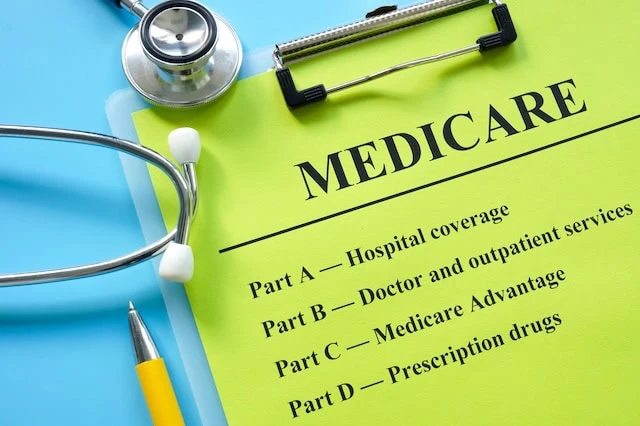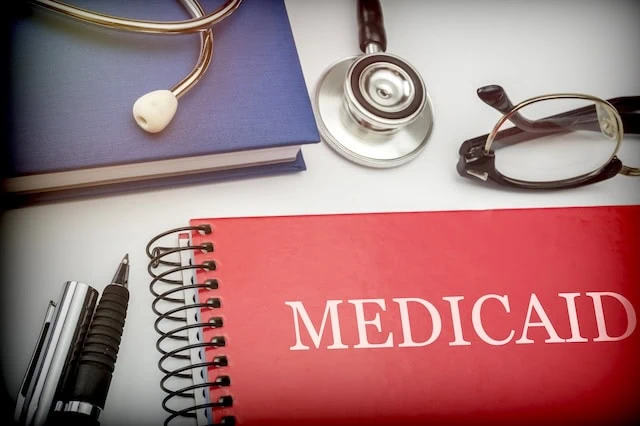Medicare is typically more affordable than private insurance, but that doesn’t mean it’s necessarily cheap—and it certainly doesn’t mean it will fit within your budget.
You can’t exactly haggle your way to better premiums or medical care costs, either. Oftentimes, the best you can do on that front is shop around for different Medicare Advantage (Part C) plans, but if you want to go with a combination of Parts A, B, and D, those generally have set costs.
But there are other ways—many other ways, in fact—you can keep your Medicare costs down.
Today, I’m going to introduce you to several actions you can take to limit your Medicare costs. Some of these strategies apply to everyone, while others are limited to specific groups of people, such as those with low incomes or disabilities.
How Much Does Health Care Cost in Retirement?

Part of your retirement planning should include budgeting for health care expenses, but that can get tricky.
Consider this: According to Fidelity Research, a single person can expect to pay about $157,500 after tax for health care costs in retirement, while a couple can look to pay about $315,000.
However, your costs might be wildly different. For one, those numbers don’t even include long-term care. Also, the state of your health might affect your medical expenses. Your income could impact how much you pay for certain parts of Medicare. (You can check out our related article for a fuller breakdown of health care costs.)
Today, though, I’m going to focus specifically on Medicare costs—namely, how you can reduce them.
Do you want to get serious about saving and planning for retirement? Sign up for Retire With Riley, Young and the Invested’s free retirement planning newsletter.
Want More Affordable Medicare? Do This

I say “Medicare costs” because there are a number of costs involved—beyond premiums, there are also deductibles, copays, and/or coinsurance to consider, too.
And while Medicare is typically more affordable than private insurance, it’s not free, and it could be a financial strain on some retirement budgets.
However, you can alleviate at least some of that strain by taking these Medicare-related actions.
1. Sign Up On Time

Most people don’t just wake up one day and have Medicare. Some do—specifically, those who have been receiving Social Security or Railroad Retirement Board benefits for at least four months before turning 65—but most people need to enroll. And there are multiple enrollment periods:
- Initial Enrollment Period (IEP): Begins three months before you turn 65 and ends three months after you turn 65.
- An exception: If your birthday lands on the first of the month, your IEP starts four months before you turn 65 and ends two months after you turn 65. For example, if you were born on Aug. 1, your IEP runs from April to October.
- General Enrollment Period (GEP): Jan. 1 to March 31 each year.
- Special Enrollment Period (SEP): Some events trigger an SEP, such as dropping out of an employer plan, losing Medicaid coverage, or being released from incarceration.
If you don’t sign up during your IEP (and you don’t have similar coverage, through, say, a workplace plan), then you’ll have to wait to sign up during the GEP. If so, you may also be subject to a late enrollment penalty, which is assessed through increased monthly premiums. While you’ll usually only pay the Part A penalty on a temporary basis, penalties for Parts B and D generally last a lifetime.
Typically, there is no penalty when you enroll during a Special Enrollment Period, but you must qualify for one, and they are only available for a limited time after the triggering event.
Related: Plan for These 7 Hidden Retirement Costs
2. Carefully Choose Between Original Medicare and Medicare Advantage

Original Medicare is Medicare Parts A (hospital insurance) and B (medical insurance). They don’t cover prescriptions, but you can get that coverage through Part D (prescription drug insurance).
Medicare Advantage (MA) is Medicare Part C, which is offered through private insurers and includes coverage provided through Parts A and B, and often includes the prescription coverage offered through Part D
You can get coverage through either Original Medicare or Medicare Advantage, but not both.
Medicare Advantage is typically cheaper on the premium front, but that can depend on the plan you have:
- Original Medicare: Part A is typically free. Part B starts at $185 per month in 2025. Part D is a separate expense and is expected to average $46.50 per month in 2025.
- Medicare Advantage: You have to pay both the Part A and Part B premiums, so that’s a wash. The Medicare Advantage premium itself will vary by plan, but the majority of MA plans (75% in 2024) have no separate premium. And you don’t have to pay Part D premiums.
Where the cost differences really start to add up involve the plans themselves.
One of Part C’s biggest advantages is the cap for out-of-pocket costs, which for 2025 is a maximum of $9,350, though some plans might have lower caps. Original Medicare has no limit on out-of-pocket costs—the only way to cap those costs is to buy a Medigap (supplemental insurance) plan, which for 2025 has an out-of-pocket maximum of $7,220.
Part C also covers some dental, hearing, and vision services. Original Medicare doesn’t, so if you went with Parts A and B, you’d also need to find additional coverage for those needs or pay fully out of pocket.
That said, Original Medicare does have some cost advantages.
Medicare Advantage plans typically require you to receive care within a geographically limited network or pay a premium for out-of-network coverage. Original Medicare will let you see any doctor in the U.S. that accepts Medicare—so if you plan to do a lot of domestic travel, Original Medicare could help you avoid high out-of-network costs.
Also, Original Medicare doesn’t require you to get a referral to see a specialist, so it could cut down on unnecessary primary-care visits.
Related: Don’t Overpay for Medicare: How to Avoid the Late Enrollment Penalty
3. Consider Medicare Supplement Insurance (Medigap)

Along those lines, if you do go with Original Medicare, Medigap could reduce your costs.
Medigap, which is the much shorter name for Medicare Supplement Insurance, is optional, supplemental coverage that people with Original Medicare can purchase from a private insurance company. It works with any hospital or doctor that accepts Medicare, and it can help you pay your share of out-of-pocket expenses that Original Medicare doesn’t cover. Some Medigap plans also have out-of-pocket maximums.
Your chosen policy determines how much coverage you receive. Plans that carry the same letter must offer the same basic benefit—price is the biggest difference.
Massachusetts, Minnesota, and Wisconsin Medigap policies are standardized differently. Also, some states allow you to buy Medicare SELECT, another type of Medigap policy; people with Medicare SELECT can switch to a standard Medigap policy within 12 months if they no longer want a SELECT policy.
Lastly, Medicare Advantage policyholders cannot get Medigap coverage.
Related: Medicare FAQs: Your Questions Answered
4. Consider Medicare Part D

If you have Medicare Part A and/or Part B, you can also sign up for Medicare Part D—Medicare drug coverage—which helps users pay for generic and brand-name drugs. You can’t sign up for Part D if you use Medicare Advantage, but many of those plans already include drug coverage.
Like with other Medicare plans, you should sign up for Part D when you first become eligible, even if you don’t currently take prescription drugs. Late enrollment may result in a penalty, charged in the form of higher premiums as long as you have Part D.
Note that people with higher incomes sometimes need to pay an extra amount (separate from the plan premium) for Part D, which is sometimes called Part D-IRMAA. For 2025, the income limits are $106,000 for individuals or $212,000 for those married and filing jointly. The amount increases by income and maxes out for individuals who make $500,000 or more and couples who make $750,000 or above. Depending on your income, for 2025, the increase ranges from $13.70 (plus the plan premium) to $85.80 (plus the plan premium).
Part D premiums can be taken directly out of your Social Security check, deducted from a checking or savings account, charged to a credit or debit card, or billed via mail and paid for by check.
Is Part D worth it? According to The Medicare Prescription Drug Program (Part D) Status report from March 2024, multiple surveys show that Medicare Part D beneficiary satisfaction exceeds 90% and over 80% of enrollees say that Part D plan costs are reasonable.
Related: Here’s How You Can Lose Medicare [And How You Won’t]
5. Use Money From a Health Savings Account

If you’re struggling to pay for your portion of health care costs while you’re on Medicare, using funds from a health savings account (HSA) is an excellent option.
HSAs have a number of benefits. Primarily, you can withdraw funds tax-free if the money is spent on qualified medical expenses (QMEs). As far as Medicare is concerned, those QMEs include things like premiums, deductibles, copayments, and coinsurance.
Also, you don’t have to reimburse yourself right away—you can actually reimburse yourself for medical expenses years after they occurred (as long as you have proper documentation). Waiting until later to reimburse yourself seems like an odd choice, but if your HSA money is invested, waiting gives those funds more time to grow.
Just remember: Once you’re enrolled in Medicare, you are no longer permitted to open or contribute to a health savings account (HSA). In fact, to be safe, you should stop contributing to your HSA at least six months before applying for Social Security retirement benefits to avoid any possible tax penalties.
Related: 6 Common HSA Money Mistakes to Avoid
6. Check Your Medical Bills for Errors

You can’t blindly trust that all of your medical bills are accurate. People make the bills, and people make mistakes—and mistakes could cost you. Your claim might have wrongly been denied, or you might have been charged for a procedure you didn’t actually undergo.
Thus, you should get into the habit of checking your medical bills closely, especially if the cost is much different than your expectations.
Some of the most common issues to check for?
- Incorrect patient details (e.g., your name is misspelled, a policy number is a digit off)
- Duplicate charges
- Tests, treatments, or diagnoses you didn’t receive
- A balance that looks too high based on the amount your Medicare Summary Notice or Explanation of Benefits says your insurance would have paid
If you suspect you found an error, reach out to your provider’s billing department. If that’s a dead end, try contacting Medicare for help. To ask Medicare questions about billing or your claims, you can log into your secure Medicare account or call 1-800-MEDICARE (1-800-633-4227).
That said: Don’t trust callers who claim to be Medicare representatives, say there is an issue with your account, then ask for personal information, such as your Social Security number. Medicare scams are one of the most popular scams targeting seniors.
Do you want to get serious about saving and planning for retirement? Sign up for Retire With Riley, Young and the Invested’s free retirement planning newsletter.
7. Apply for Medicaid

Medicaid is a joint state and federal program. Federal law mandates states to cover specific groups of individuals, such as seniors, low-income families, qualifying pregnant women and children, and people receiving Supplemental Security Income (SSI).
Generally, Medicaid beneficiaries have to be residents of the state in which they receive Medicaid. And depending on your state, additional groups of people may be eligible.
There are two ways you can apply for Medicaid. You can either visit HealthCare.gov and click “Check for all savings options” on your application or visit Medicaid.gov to apply directly with your state.
If you apply for Medicaid and are denied, states must offer you the opportunity to request a fair hearing about the denial.
Related: When Should You Take Social Security?
8. Apply for Supplemental Security Income

You may qualify for Supplemental Security Income (SSI) if you have little to no income and resources. In 2025, individuals generally can’t earn more than $2,019 from work each month to be considered low income enough. The limit rises for couples and parents applying for kids. In addition to employment income, the Social Security Administration considers pension income, disability benefits, and unemployment when determining eligibility.
The value of your resources, such as bank account balances or cars, typically can’t exceed $2,000 for individuals or $3,000 for couples. The limits increase by $2,000 for parents applying for children.
Additionally, one of the following must be true:
- You are 65 or older.
- You are blind.
- You have a disability.
Adults who qualify through a disability must have a disability that affects their ability to work for a year or longer or will result in death. For children, the disability must significantly limit their daily activities. People with disabilities must also prove that their work earnings totaled less than $1,550 per month in the month they apply.
If you’re unsure about your eligibility, you can call 1-800-772-1213, or if you’re deaf or hard of hearing, TTY 1-800-325-0778. You can use those same numbers to set up an appointment to apply for SSI. People with blindness or other disabilities can also apply online for disability benefits. Alternatively, you can call your local Social Security office to schedule a telephone appointment or visit the SSA website and request a representative to call you.
Related: RMDs Too High? 6 Ways to Reduce Them at Age 73
9. Apply for a Medicare Savings Program

Medicare Savings Programs (MSPs), as the name implies, are state-provided programs that help Medicare recipients pay for their Parts A and B premiums.
To qualify for an MSP, you’ll need to have Medicare Part A and meet your state’s income and asset limits. Your assets may include stock market investments (stocks, bonds, etc.) real estate, retirement accounts, and bank accounts. The exact income limits vary by state.
Some states don’t count some types of assets, and no states include your primary home, one car, life insurance with a cash value under $1,500, or burial plots. Your state might require you to apply for other benefits, such as Social Security, before approving you for an MSP.
To apply for these programs, you can contact your state’s Medicaid agency through the Medicaid website or use the free BenefitsCheckUp online tool.
Let’s look at the four Medicare Savings Programs available:
Qualified Medicare Beneficiary Program

The Qualified Medicare Beneficiary (QMB) program helps low-income Medicare beneficiaries pay for a number of medical expenses. Specifically, if you quality for QMB, you will receive assistance for your Parts A and B premiums, and Medicare providers cannot bill you for Parts A and B deductibles, coinsurance, and copayments for Medicare-covered services and items. (However, if a Medicaid copayment applies, you might get a bill.)
To qualify for the program, you must meet certain income limits, which adjust annually based on the federal poverty level. One’s monthly income must be at or below the annual federal poverty level.
However, individual states are allowed to set different thresholds. Currently, the income limits are slightly higher in Alaska and Hawaii. In some other states, you might be eligible even if your income or resources are higher than the limit.
Every year, beneficiaries must resubmit updated income and resource information.
Related: 10 Senior Discounts for Restaurants + Grocery Stores
Specified Low-Income Medicare Beneficiary Program

The Specified Low-Income Medicare Beneficiary (SLMB) Program helps beneficiaries pay for Part B premiums. Similar to the QMB program, there are federal income limits, but the limits are a bit higher in Alaska and Hawaii, and other states may allow you to qualify with a higher income or resource limit. Always contact your state to find out.
If you’re eligible for the SLMB program, you can also get Extra Help (more on this later).
Related: How Long Will My Savings Last in Retirement? 4 Withdrawal Strategies
Qualifying Individual Program

The Qualifying Individual (QI) Program is another way people can get help paying for Part B premiums. Like the QMB and SLMB programs, income and resource limits can vary by state.
To be eligible for the QI program, a person must have both Parts A and B, and must reapply each year. States approve applications on a first-come, first-served basis, but prioritize individuals who had QI benefits the previous year.
You can only have QI if you aren’t eligible for any other Medicaid coverage or benefits, but you can still qualify for other Medicare Savings Programs. If you get assistance from the QI program, you also get Extra Help.
Related: What to Do With Your 401(k) When You Retire
Qualified Disabled & Working Individual Program

The Qualified Disabled & Working Individual (QDWI) Program helps pay for Part A premiums. You may be eligible if the following describes you:
- You have a disability.
- You’re working.
- You lost your Social Security disability benefits and premium-free Part A because you started working again.
In 2025, the income limit to qualify is $5,302 for individuals and $7,135 for married couples, while the resource limits are $4,000 for individuals and $6,000 for married couples.
Alaska and Hawaii have different income limits, and similar to other Medicare Savings programs, you may qualify in some states even if your income and/or resources exceed the federal thresholds.
Related: Want to Retire Early? Don’t Make These Mistakes
10. Get “Extra Help”

The Extra Help program provides low-income beneficiaries with financial assistance for Medicare Part D costs, including premiums, deductibles, and coinsurance.
In 2025, if you qualify for Extra Help, you’ll pay $0 in plan premiums and deductibles, up to $4.90 for each generic drug, and up to $12.15 for each brand-name drug. When your total drug costs (including payments made on your behalf by Extra Help and other programs) reach $2,000, you’ll pay nothing for any covered drugs for the rest of the year.
Also, people with Part D late enrollment penalties don’t need to pay them while they receive Extra Help.
You automatically receive Extra Help if you get one of the following:
- Supplemental Security Income (SSI) benefits
- Full Medicaid coverage
- Help from your state paying Part B premiums
Even if you don’t automatically receive Extra Help, you can still apply. Eligibility is based on income and resources. The income and resource limits are $23,475 and $17,600, respectively, for individuals, and $31,725 and $35,130, respectively, for married couples. People can apply before or after enrolling in Part D.
You can set up an appointment to apply by calling 1-800-772-1213, or if you’re deaf or hard of hearing, TTY 1-800-325-0778 (the same number you contact to apply for SSI). Eligibility is reviewed every year.
Related: 10 Pros + Cons of Pets During Retirement
11. Apply for a Special Needs Plan

A Special Needs Plan (SNP) offers services and benefits to people with certain severe and chronic diseases or health care needs, as well as to people who have Medicaid.
SNPs are either HMO- or PPO-type plans, and they not only provide the same Parts A and B coverage that Medicare Advantage plans provide, but also drug coverage. An SNP may provide more, such as extended hospital stays, but it’s not required to.
To qualify for an SNP, you must have Medicare Parts A and B. You also need to live in the plan’s service area—they are not always available in all parts of the U.S. Finally, you must meet the eligibility requirements for one of the following three types of SNPs:
- Chronic Condition SNP (requires doctor’s note)
- Dual Eligible SNP (requires proof of Medicaid)
- Institutional SNP (must have lived in a long-term facility covered by the program for a minimum of 90 days or meet your state’s requirements for high-level care)
Although some plans charge a premium, if you have Medicare and Medicaid, most of the costs should be covered for you.
Generally, you need to enroll in an SNP during Medicare Advantage enrollment periods. You may also qualify for a special enrollment period if there are changes in your health, employment status, location, or plan.
Want to talk more about your financial goals or concerns? Our services include comprehensive financial planning, investment management, estate planning, taxes, and more! Schedule a call with Riley to discuss what you need, and what we can do for you.






![SEP IRA Contribution Limits [2025 + 2026] 38 SEP IRA contribution limits](https://youngandtheinvested.com/wp-content/uploads/SEP-IRA-contribution-limits-600x403.webp)

![How to Make $50 Fast [Several Ways to Get $50 Or More] 40 how to make 50 fast](https://youngandtheinvested.com/wp-content/uploads/how-to-make-50-fast-600x403.webp)
